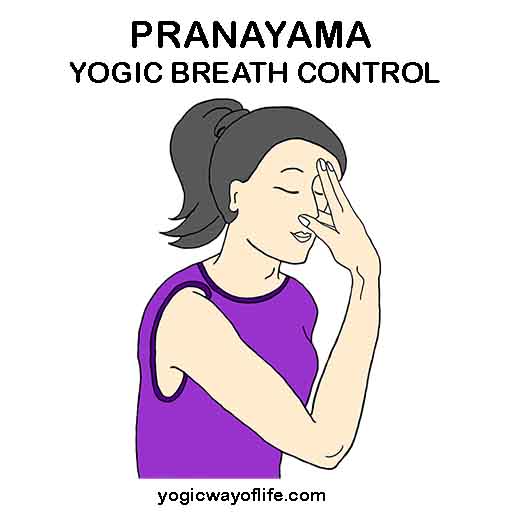Pranayama is the yogic science of breath control. Yoga teaches that breathing can be regulated and controlled for various health and spiritual benefits.
Man inhales and exhales from the time he is born till his death. Breathing provides the vital energy required for sustenance of the body. Sometimes the breath is shallow and sometimes it is deep. Sometimes the breath stops for a moment or so. All these happen naturally, even during our sleep. It is an unconscious activity, controlled by our central nervous system.

Pranayama consists of yogic techniques, not only to make you conscious of this process of breathing, but also to control it. The inhalation (called Puraka), exhalation (called Rechaka) and stoppage of breath (called Kumbhaka) are practiced consciously in the various pranayama techniques. Through these techniques, one can eventually control the underlying prana, which is the subtle energy responsible for life itself.
Controlling prana is like trying to control a wild elephant. It seems impossible in the beginning. But with constant practice, the prana, like the elephant, can be brought under control. This is the goal of pranayama.
Prana and the mind have a close relationship. The mind and senses need prana to function. The mind may cease to be during deep sleep, but the prana is ever active till one leaves the body. Hence, in the Upanishads, Prana is declared as even superior to the mind and the senses. When the prana is controlled, the mind becomes controlled naturally.
The ancients recognized that the rate of breath had a correlation with longevity. Animals that breathe fast have shorter life span. For example, dogs breathe at a rate of 20-30 times per minute and can live for 10-20 years. The giant tortoise breathes at a rate of 4 times per minute and lives up to 150 years. Lower the breath rate, higher the life span. Humans breathe at a rate of about 15 times per minute. In advanced yogis, the average breath rate is much lower and this contributes to their long life. Lower breath rate reduces the load on the heart and keeps it going for more years.
In Patanjali Yoga Sutras, Pranayama is mentioned as the fourth step or limb of Yoga. It is usually done after asanas or postures. It leads the practitioner to the next stage called Pratyahara or internaliing of the mind. The techniques of pranayama were developed as a prelude to meditation. The mind is constantly flooded with thought patterns or ‘Vrittis’ which seem uncontrollable. The practice of pranayama slowly and steadily brings these modifications under control. Meditation requires a quite mind and pranayama is a great way to achieve that stillness.
There are various types of pranayama, but the most important one is the Anulom Vilom Pranayama. It consists of inhalation (puraka), retention of breath (kumbaka) and exhalation (rechaka). This is mentioned in various texts including the Upanishads, Puranas, Hatha Yoga Pradeepika, Siva Samhita, Uddhava Gita, Tirumandiram, etc to name a few. Most of the texts recommend a ratio of 1:4:2 for inhalation, holding of breath and exhalation. The breathing is done alternatively, first through the left nostril and then through the right nostril, which is counted as one round of pranayama. The number of rounds and the duration of each round define the various levels of pranayama practice. This process slowly brings about control of respiration. The breathing becomes deeper and slower increasing the efficiency of your lungs and decreases the strain on the cardiac system.
Good athletes have a basal heart beat rate of around 60, while the average human heart does 72 beats per minute. It is a sign of strong and efficient cardiac system, which is required for higher performance. With pranayama practice, we see similar results in the heart rate as your system functions more efficiently.
The Hatha Yoga Pradeepika mentions other types of pranayama as well, each with a specific benefit. They are Surya Bheda, Ujjayi, Sitali, Bhastrika, Bhramari, Murcha and Plavini. Kapalabhati is listed under Shad karmas rather than under Pranayama, even though today it is taught as a form of pranayama.
Thus we see that pranayama has a direct effect on the body as well as the mind. It improves health, gives longevity, gives a serene mind fit for meditation and contemplation and creates a sense of well being. That is why pranayama is equally popular, among fitness enthusiasts as well as spiritual seekers.
